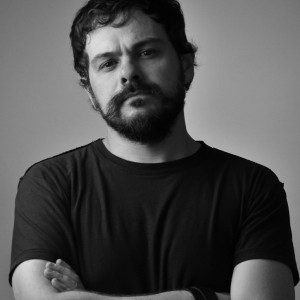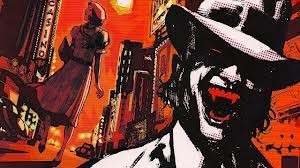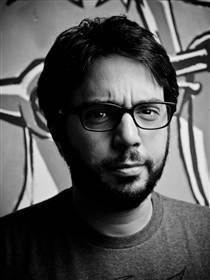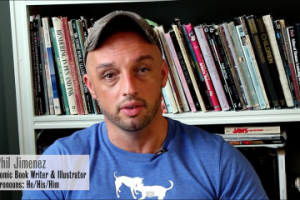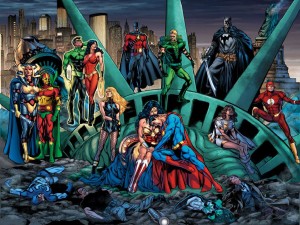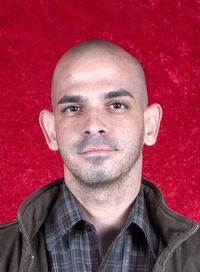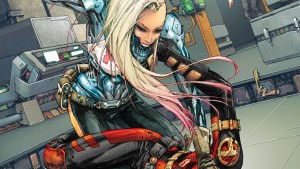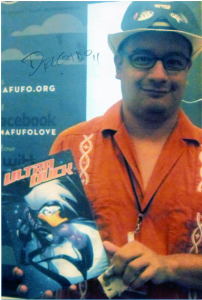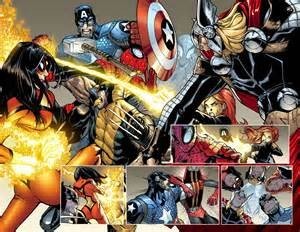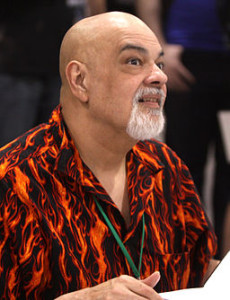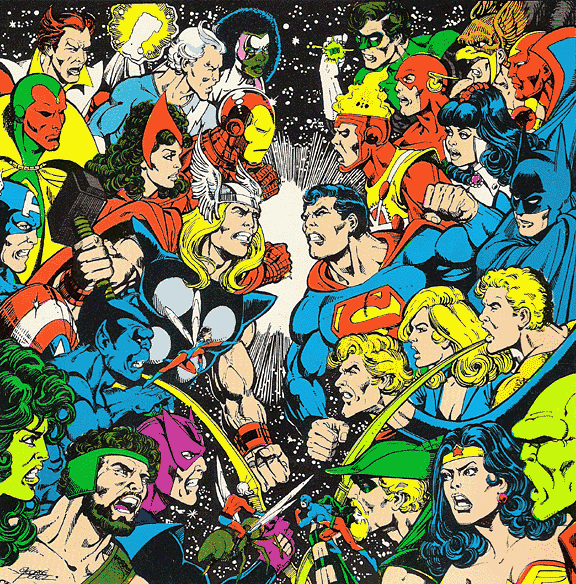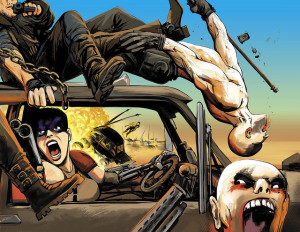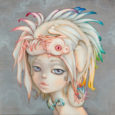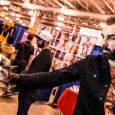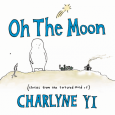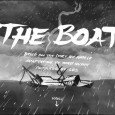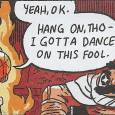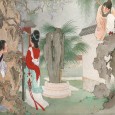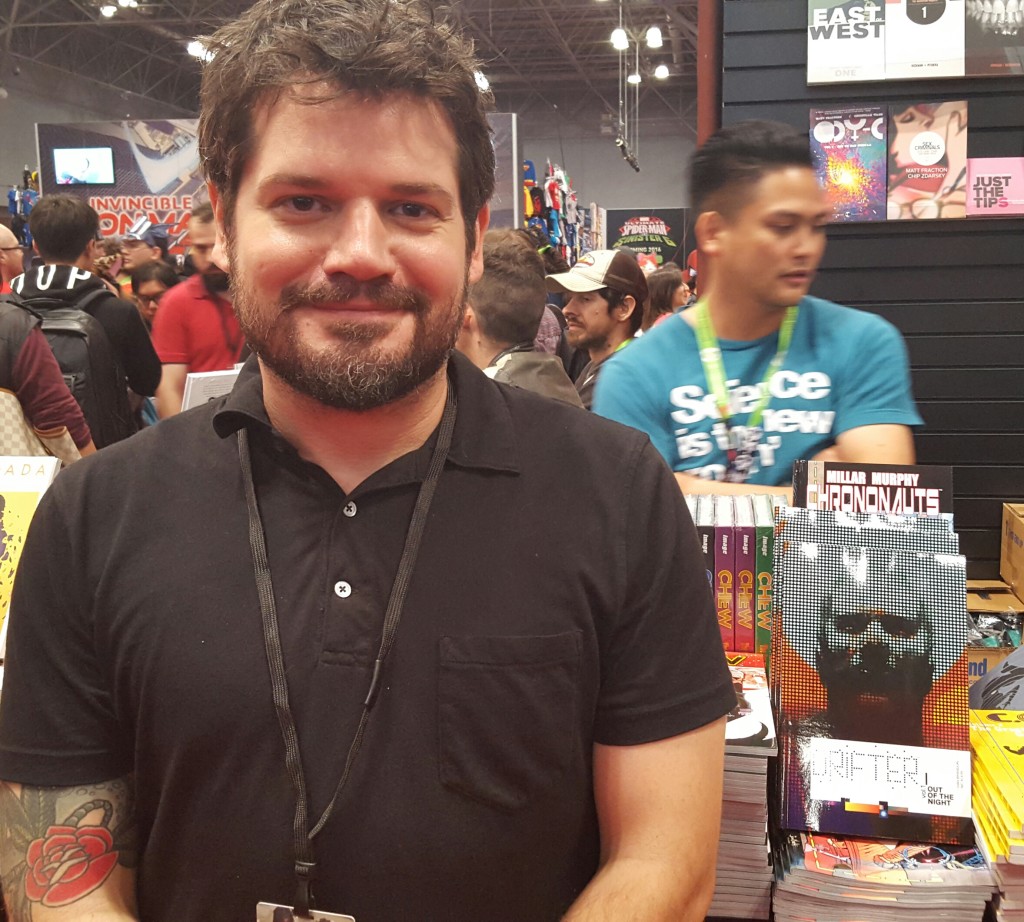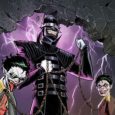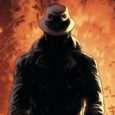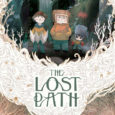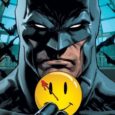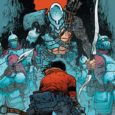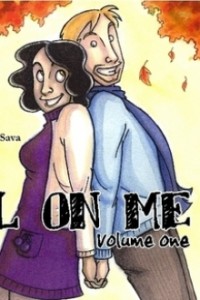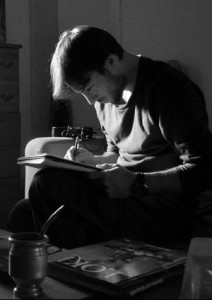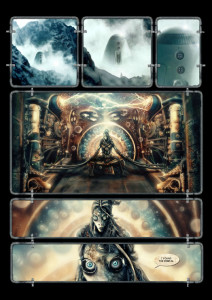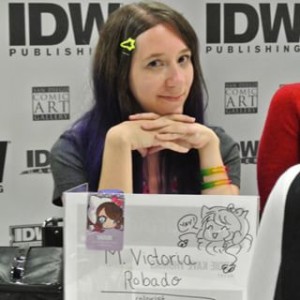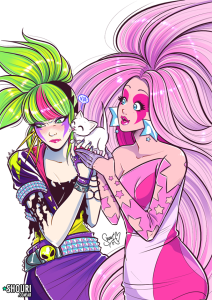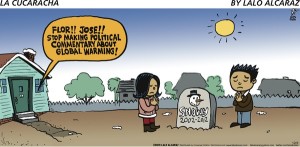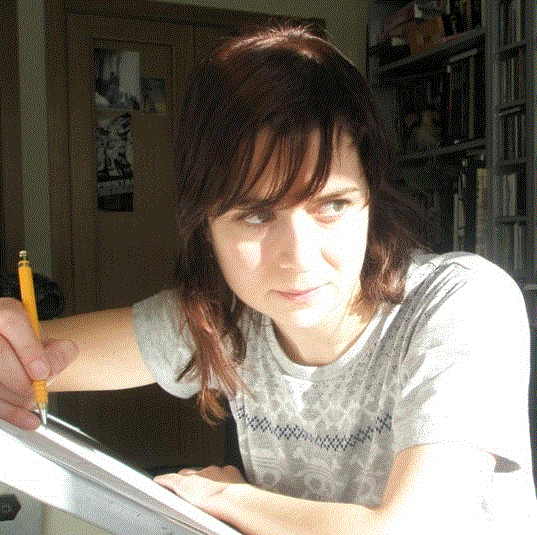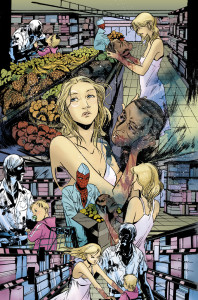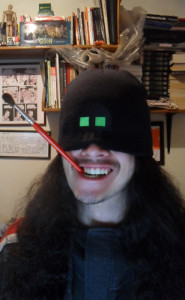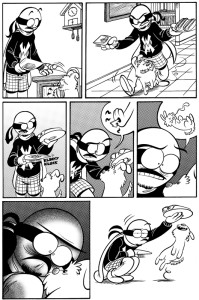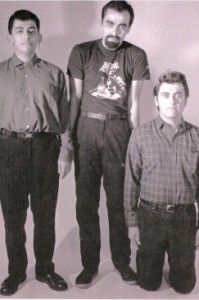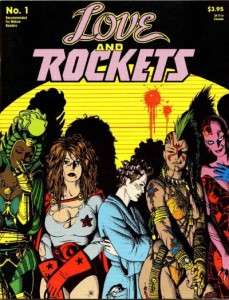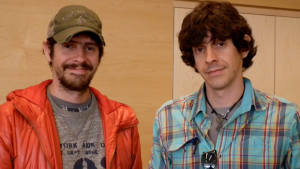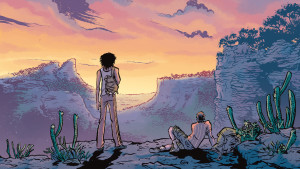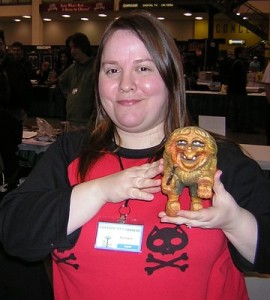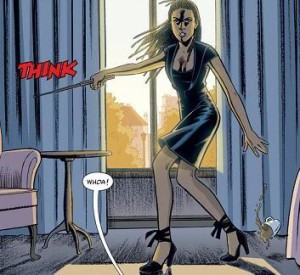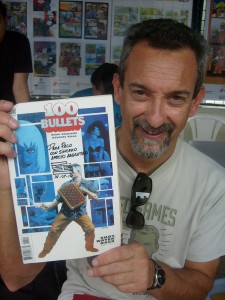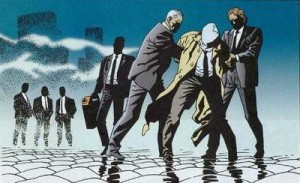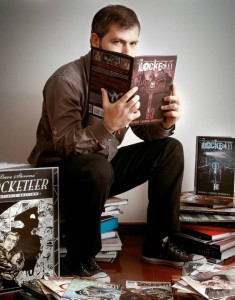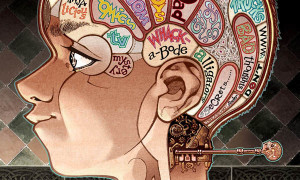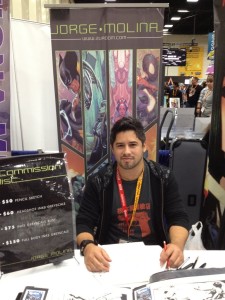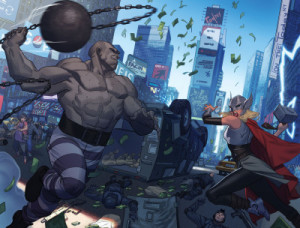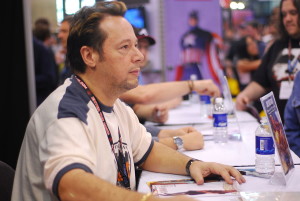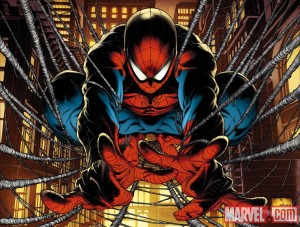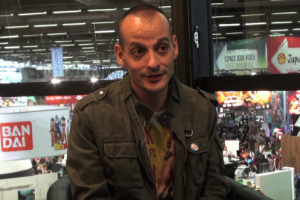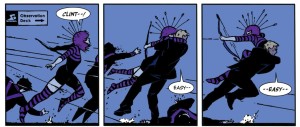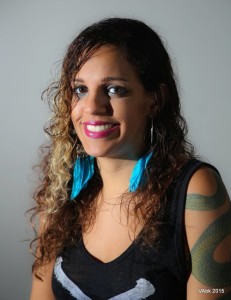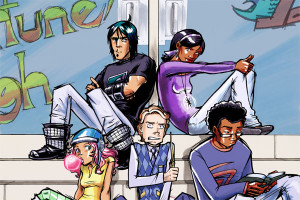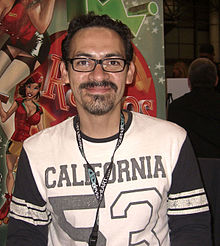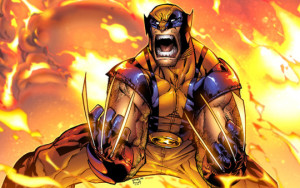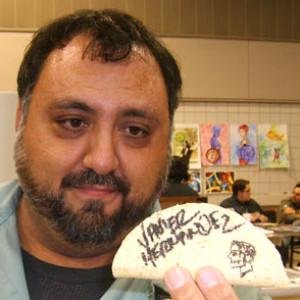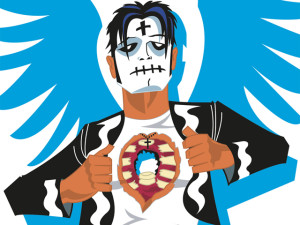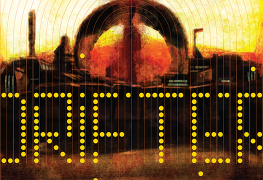After our conversation with Cuban writer Ivan Brandon (Drifter) at New York Comic Con, we felt a push to highlight some more Hispanic comic creators and artists during the last days of Hispanic Heritage Month (September 15- October 15). Check out if your favorite artists made the list below as well as in part 1 and part 2 and be pleased as we were to note that most of them sit at the top of our lists of favorite artists of all time.
Raphael Albuquerque
This talented Brazilian artist is best known for his work on Blue Beetle and as the co-creator with Scott Snyder of American Vampire, which won the Eisner Award for best new series in 2011.
Gustavo Duarte
This Brazilian cartoonist and illustrator is currently working on DC’s adorable Bizarro with Heath Corson. His previous works have been collected and published by Dark Horse.
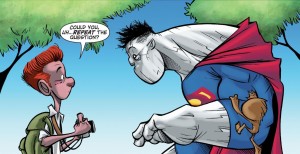
Phil Jimenez
This openly gay half Irish-half Mexican American artist is known for his LGTBQ advocacy as well as his award-winning tenure in the industry. He is loved for his collaborations with Grant Morrison (New X-Men, The Invisibles) as well as his run on Wonder Woman.
Kenneth Rocafort
This Puerto Rican artist has been beautifying and sparking controversy in the pages DC comics with his work on Red Hood and the Outlaws and Teen Titans. His work has been consistently unique and gorgeous since his days on Wolverine/Punisher and Madam Mirage.
Alvaro Lopez
Inkers never get enough love from comic fans, so we decided to mention this prolific Spanish artist who has worked on both Marvel, DC titles. 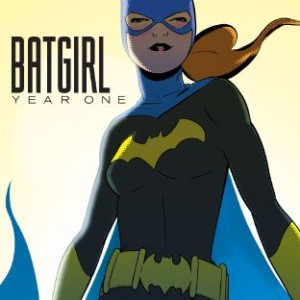
Edgar Delgado
In our interview with Ivan Brandon at NYCC, we commiserated on our inability to name any Hispanic colorists. Luckily, Brandon was able to save the day. This Mexican colorist has worked on Marvel titles including The Amazing Spider-Man and World War Hulks.
George Perez
This legendary Puerto Rican artist defined DC and Marvel comics in the 1970’s and 1980’s in the pages of Teen Titans, Avengers, and Wonder Woman.
Javier Rodriguez
This Spanish illustrator and colorist is best known for his lovely work on Batgirl: Year One and The Amazing Spider-Man and Daredevil.
Quick, push us to compose a pt 4 before Hispanic Heritage Month ends on October 15th! Shout out your favorite Hispanic Artists in the comments below.
Kaitlyn D
Content Editor
@deadrabbit92
Ivan Brandon (Viking, Wolverine, Men of War) is a huge talent over at Image Comics. His current series, Drifter, is a stellar scifi project with long-time collaborator Nic Klein (Thor, Captain America). The series has earned praise for its world-building and beautiful artwork as well as favorable comparisons to genre-giants like Frank Herbert’s Dune.We consider ourselves incredibly lucky to have interviewed the elusive Brandon this year at New York Comic Con about Drifter, Hispanic Heritage Month, and the changing comics industry.
SC: One of the most interesting aspects about the world building in Drifter is the hybrid society that is created by the human presence on an alien planet. How do you pick the recognizably human elements to form your world and how do you decide to create something new? Basically, when do you use trucks or when do you use land-speeders?
IB: Some of it is practical and some of it honestly is gratuitous and what we think is going to look the coolest. A lot of the point to this world and the way it functions is that it is sort of kneecapped in a lot of ways. It has limited capabilities. We don’t want every single character to have the ability to cross of the entire planet at will. They don’t have fuel sources; they don’t have other things.
Some of it is that you’ll just absolutely need something for a scene, so that will justify it. But we are trying to keep the means limited. We’re trying to keep a real cost for people as far as in terms in achieving their personal tools.
SC: Do you think that “kneecapping” is necessary for the space western genre? Does there need to be recognizable modern or premodern human elements to reference but also limit the capabilities of the characters?
Well you know, here’s the thing: The western stuff is sort of incidental. Or not incidental, but the point of the western is really less about the genre or shtick and more about the idea of us figuring out colonizing a planet untouched by humans. You wouldn’t send Donal Trump there, so what kind of people would be sent there? We wanted sort of dirty scifi, people with dirty hands and people who are there to get into the nitty-gritty and not there to live in a fancy apartment.
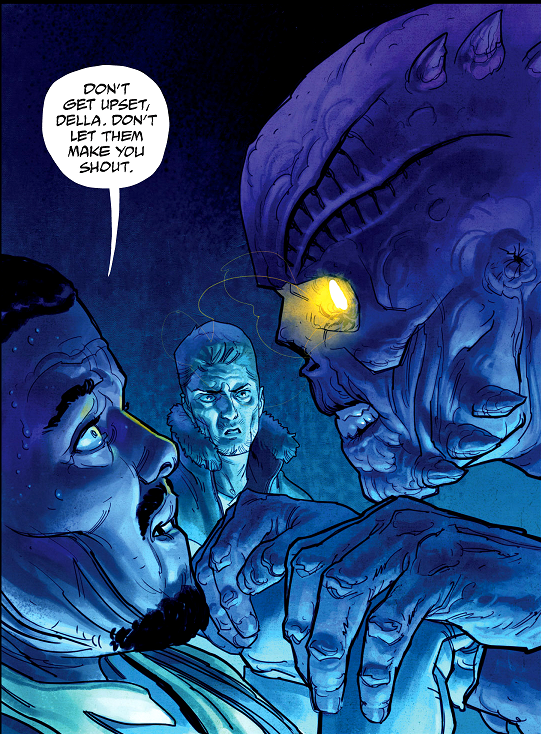 SC: Related to that idea, we were wondering if you could talk about your villains. The wheelers are terrifying but so too was Father Arkady. Which do you think is a scarier concept and why?
SC: Related to that idea, we were wondering if you could talk about your villains. The wheelers are terrifying but so too was Father Arkady. Which do you think is a scarier concept and why?
IB: I think Arkady is terrifying in a different way because he embodies a lot of what the story is about: transplanting society without the constructs of society. So, when you transplant the church and its beliefs through a lot of distance and a very damaged person, that’s a very terrifying idea and it clearly leads no where good.
The idea of the wheelers is, especially in the second arc which is largely about the wheelers, important because they are sort of the alpha species and it’s the first time humans have to interact in an environment where they don’t lead and they’re not the alpha predator. So that’s sort of a very humbling thing; humans are not very used to humility in this day and age. It’s not something that is built into our culture right now. I think the depths of that are more terrifying because people have no concept of what that will lead to.
SC: Further speaking on terrifying creatures: Will “the bear” make another appearance?
IB: Not in this arc.
SC: Well we are definitely excited for what is to come in Drifter, but we’re always interested in artists to share the behind-the-panels process. We know that you and Nic have worked together before and we were wondering what your process with him was like. Do you give him a strict outline or a general concept to work with?
IB: It’s sort of somewhere in the middle. At every stage of the planning process Nick and I are talking about everything. A lot of the major story stuff, which I can’t explain because it would spoil the entire story, came from Nick. At no point am I dictating things to Nick; he’s involved and making decisions in the story. Before I script anything, we’ve decided more or less what is going to happen. Obviously the script itself lends to the organic process of writing a script and things will change and diverge while the characters can be sort of hard-headed and do what they want regardless of what Nick and I have decided.
In terms of what the actual layout is for art, I try to give him as specific an idea as I can. If I have a very specific visual I will give it to him, but there is always a disclaimer at the front of my scripts that will say “absorb it as if you were looking at reference, and then discard it and do something better.” I always say that the ultimate performance of the story is all Nick, the artist. For me to tell him to draw exactly one thing is silly because Nick knows how to better express within his skill-set. For example, issue #9, which is the last issue of the second arc, is 34 pages long because Nick literally added ten pages of expanded a sequence that he made so huge. It was sort of unfathomable to me until I saw it.
Occasionally, of course, I will go back and look at it and be like “I don’t think you caught the emotion of this character,” or whatever it is. We can go back and forth a little bit. But the ultimate performance is Nick’s.
SC: Are you two planning any future projects?
IB: We’ve got a couple years left on this. We’ll probably be doing this until somewhere around issue #30-ish. After that, yeah. We had a little lapse between Viking and this where our schedules didn’t align and it’s definitely my goal going forward to never have that lapse again. Nick and I have such a great working relationship with a great symbiosis. We’re very different people. We have very different tastes and very different perspectives. Somehow, in an odd-couple way, they just sort of complement each other to hopefully build something that is unique and fun.
SC: Have you read any of the other space westerns that are out like Copperhead or East of West?
I’ve read some of East of West; I haven’t read any of Copperhead. Unfortunately, just like everyone, I have this crazy stack of books in my office that just gets taller. I know that there’s a few things going on and even by some other publishers. From what I can tell from those two particular books is they’re much more about the western genre than mine is. I try to sort of stay away from anything that is even incidentally similar because I don’t want to gum up the works of my own brain and where I am headed. I almost don’t even like to accidentally step on the same idea at all. I almost don’t want to know.
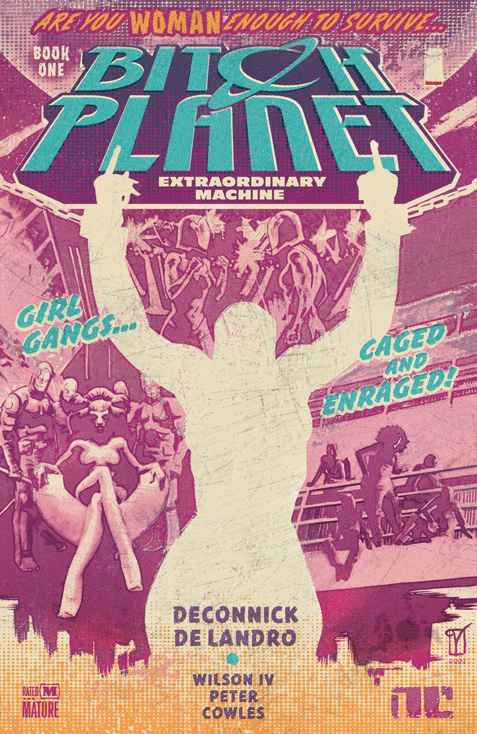 SC: What are you reading right now?
SC: What are you reading right now?
IB: My favorite book right now, period, is Southern Bastards. That’s my number one favorite book. No coincidence, my favorite book before that was Scalped. I think Jason Aaron by himself is a phenomenal storyteller but Jason and Letour are a real great team up.
I enjoy Sex Criminals a lot. I’m looking at the wall behind us [at the Image booth] I really like Supreme Blue Rose and Bitch Planet. Bitch Planet has a really cool story: When I was at a signing in San Francisco, my mom came, which she never does. I don’t see her all that often because she lives in San Francisco and I live in New York. At some point, my mom says “What is this Bitch Planet? How do I read it?” And literally, I did another signing the next night and when I got to my table there was a stack of Bitch Planets with a little post-it note that said “For Ivan’s Mom.” The shop had provided all these issues, which is pretty awesome.
SC: Did she enjoy it?
IB: She loved it. But, I also loved Deadly Class. I think it’s literally pound for pound, though we don’t have a Watchmen going on right now, the best and most diverse line up in history.
SC: Absolutely, Image has been closing on the big two and its diverse range of books and creators have a lot to do with that.
IB: I didn’t even just mean Image! I meant in general. It’s the best time for comics that I have ever seen.
SC: That segues a little into our next question. Do you think that there is still an insider club mentality in the industry?
IB: This is a discussion that has been going on a lot recently and this weekend. As a Latino guy, it’s important to me. But I think that the insider club is less about deliberately trying to keep anybody out than people’s personal subconscious bias. Look, on the very basic level, I think people as a society are sort of taught that your leading man, or character rather, is a blonde–well look, I’m predisposed to even say man. But your leading character is a blonde, straight, white person. I think even for Latino, Black, or whatever, your brain is predisposed to see those things. You know, I grew up in a neighborhood where everybody mostly spoke Spanish, so I didn’t grow up in that culture at all, though you still watch it on TV and you read it in books. So your brain immediately being like “This guys name is name is Jack,” or whatever it is. So you have to go out of your way to be like “No no no, that doesn’t make any sense.” It’s a conscious effort, even for people of color, to write characters that are not the stereotype of the white guy saving the day.
So I don’t think there’s a boys club that is intentionally keeping people out. I think people have a certain level of familiarity. I do think that we have now a time where people are more open, for good or bad reasons, I’m not sure. It’s one of those things where it’s hard to judge because sometimes you think well, they’re only reacting to a public outcry. But that’s sort of how history changes and you can’t really judge the steps but what comes of it. You’ll never know why anyone did anything and maybe most of it was for the wrong reasons.
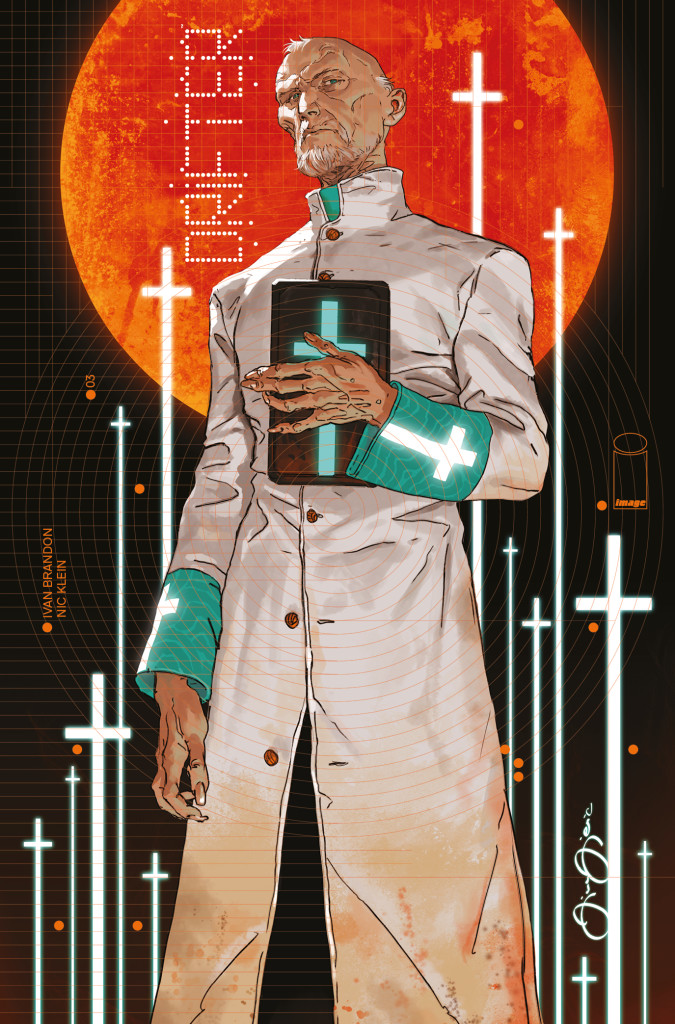 SC: So do you think call-out culture helps or does it hurt the conversations that need to be had?
SC: So do you think call-out culture helps or does it hurt the conversations that need to be had?
IB: I say it’s somewhere in the middle. I dislike the idea that we lump everyone in the internet to one person, first of all. I think that there are a lot of people that haven’t been given a voice, culturally, and now people do have a voice. Now there is a situation where there are some really good things that are happening and also some ugly things that happen. For a weird sort of lazy culture that we’re in that is very internet-centric and sitting on the couch on devices, this is our revolution. Revolutions are not tidy. They can be very unpleasant; there are very ugly steps to revolution. I think the conversations are all worth having, though they don’t all go the way that I’d hope that they would go. They get very ugly where people on both sides get shut off to win an argument. That’s not the most productive way to go forward but just that the conversations are happening at all is a huge step. Any lasting change tends to be very slow and incremental. I think this will go that way and it’s going to baby steps, and as long as you’re pointed in the right direction, those changes are going to be positive. And it’s happening faster now than I could have ever imagined. You’re not overnight going to shift a very male-centric business and comics by default is not a very progressive world. It’s been a world has had Stockholm syndrome. It’s been a world that has been about forcing people to buy whatever you told them to buy forever.
There are obviously pockets of people that are progressive and have been thinking on different terms, but it’s not been a culture that is very focused on forward thinking. I think the beauty of it though is that it is the perfect medium for it because it is the most agile. If I wanted to make Drifter about politics, next month I could. Within three weeks I could make that choice. It is the best conduit for that because you can really make really quick and smart changes with the medium. I’m optimistic. Everyone that I’ve spoken to, even people that are bristling and are skeptical of things- hey, I have white friends that are confused by things, you know? But I think everyone, for the most part, has got their heads in the right place. It’s a work in progress. But I do believe it’s a good thing and it’s worthwhile.
SC: Our last question, because it is Hispanic Heritage Month and we are trying to highlight Hispanic creators, could you name a few of your favorite Hispanic artists?
Well I should say it loud enough because we’re sitting next to Fabio Moon and Gabriel Ba who are friends of mine, so definitely not them. Paul Azaceta, who is doing Outcast is doing phenomenal work right now. It’s tough because things come in waves when people are working and then not. And sometimes in comics there are sort of hired artists who are not necessarily part of the vision of the thing, so it’s hard to make it like “oh, this is a Latino comic” just because of a name.
SC: Speaking of: your last name is Brandon?
IB: The answer to how I got that name as a Latino is that it just takes one man– we live in a patriarchal society– to screw up the names of the entire country. About four generations back I had a grandfather that was not Latino, though we continued Latino on both sides and Cuban on both sides. You only need one person to get married to a non-Latino person and the name is changed for everybody. Both my parents were born in Cuba. I’m the second oldest person of my generation born in this country.
SC: We struggled to find colorists, by the way, though we did highlight Maria Victoria Robado.
IB: No colorists? Now I’m gonna be thinking about this.* Oh but of course Paolo Rivera, who is Mexican, is phenomenal. Joe Quesada is obviously a really great artist. Eduardo Risso is easily one of the top ten humans in the business. Raphael Albuquerque is obviously a very talented guy. It’s a good time and the level of talent and enthusiasm and energy coming out of Brazil specifically right now. I’m blanking right now, it’s a good list, I just wish there were more people on it and more women on it.
*Check back for our “Highlighting Hispanic Creators pt. 3” post to see the laudable hispanic colorists that Ivan sent us!
SC: Hopefully in the future
IB: It’s slow and steady. We’re at a time now where people who had been sort of tentative about it are becoming more confident and feel like it’s a time where they might try. I have a lot of friends, non-white male friends, who love comics but are very skeptical about touching, creatively, having anything to do with it. Those people are really starting to get a sense, not that there’s going to be a utopia, but there’s a chance that they can do something unique and new, and that they might be welcomed to some degree.
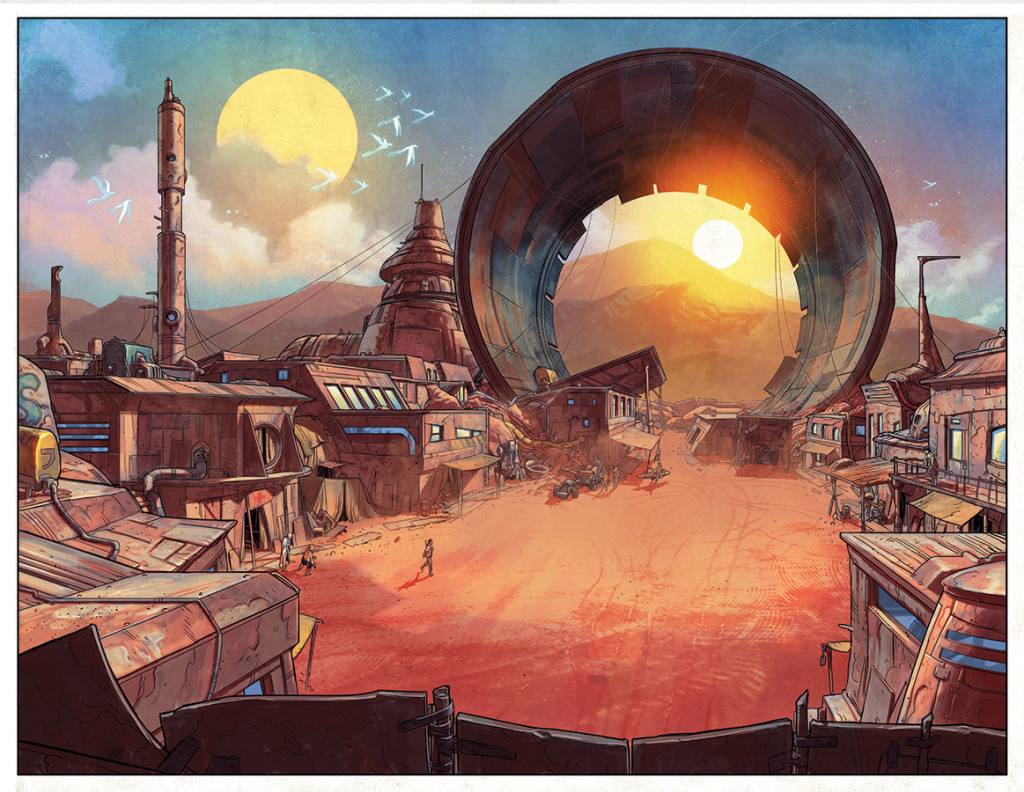 SC: That’s really encouraging, we’re sure, to Hispanic talent who are trying to break into the industry. Can we hope for any more news about Drifter?
SC: That’s really encouraging, we’re sure, to Hispanic talent who are trying to break into the industry. Can we hope for any more news about Drifter?
Nope, none. At the end of each arc we try to do a teaser image. Nick did the teaser image for the third arc. I wish I could send it to you because it’s really ominous.
SC: Well you could send it…
No such luck, guys. We want to send out a big thanks to Ivan Brandon for taking the time to talk with us. Issue #8 of Drifter is available right now and the first arc has been published as a collected volume. Be sure to catch up before the second arc wraps up in issue #9 and stay tuned for our other interviews from the floor of NYCC!
Kaitlyn D’Agostino
Content Editor
@deadrabbit92
Major faux pas confession: While researching pt 1 of this post, I tweeted @Lea Hernandez (Killer Princesses, Teen Titans Go!) and it turns out she is not actually of Hispanic descent (oops!). Mrs. Hernandez, however, was happy to shout out other fantastic Hispanic comic creators who definitely deserve to be featured during Hispanic Heritage Month, which runs September 15- October 15 (yay!). Be sure to check out pt 3 as well!
Adriana Blake
This Venezuelan-American artist is the creator of Fall On Me, the popular web comic, which chronicles her life as an artist, wife, and mother.
Patricio Clarey
We’ve mentioned the superb work of this Argentinean artist in the pages of Archeologists of Shadows, but certainly not enough can be said of his mind-blowing blend of digital, sculpture, and comic mediums.
“Shouri” Maria Victoria Robado
This Argentinean artist has been cranking up the 80’s neon glam as colorist on Jem and the Holograms and The Littlest Pet Shop.
Lalo Alcaraz
This Mexican-American political cartoonist is the celebrated creator of La Cucaracha, which is a nationally syndicated comic strip that focuses on Latino culture and politics.
Emma Ríos
Before this Spanish artist was an Eisner Award nominee for her iconic work on the Image book Pretty Deadly, she did phenomenal interiors for Marvel titles like The Amazing Spider-Man . We await the next issue of Pretty Deadly for Ríos’ art as much as we do for DeConnick’s words.
Mario A. Gonzlez
This Mexican artist is the creator of two adorably-drawn webcomics Wyliman and Clink: two series which explore the paths to and nature of heroism.
The Hernandez Brothers
Jaime, Gilbert, and Mario Hernandez were giants on the alternative comics scene with their legendary 50-issue Love and Rockets. After their collaborative title concluded, these Mexican-American creators went on to separate but still laudable projects (though have returned to work on Love and Rockets sporadically).
Who are your favorite Hispanic comic creators? Shout ’em out in the comments!
Kaitlyn D’Agostino
Content Editor
@deadrabbit92
September 15-October 15 is Hispanic Heritage Month in the US, which gives us a great opportunity to feature our favorite Hispanic comic creators. From capes to the very last man, these writers and artists have contributed years of talent and creativity to the industry and have definitely earned more credit than we can dish out in a single month. Be sure to check out part 2 and part 3 as well!
Gabriel Bá and Fabio Moon
Twin Brazilian-born brothers are giants of the industry who have collaborated on several titles including Daytripper and BPRD. Bá remains always in our hearts as the stellar artist of the too brief run of Umbrella Academy with writer Gerard Way.
Pia Guerra
This half-Chilean artist is best known for her collaboration with writer Brian K. Vaughan on the iconic Y-The Last Man. It’s sort of like being best known for inventing the lightbulb. It is impossible to give Guerra enough credit for her brilliant work on a series that has introduced comic books to so many first-time readers.
Eduardo Risso
We talk about 100 Bullets fairly often here at Sub-Cultured, and the art of Argentine Risso is probably more than half the reason. Risso has been in comics for decades and has drawn iconic characters for both Marvel and DC.
Gabriel Rodriguez
All of the artists on this list boast unique styles, but this Chilean artist’s work on the superb Locke and Key teases the line of disturbing, but settles firmly on genius. In 2015 he won an Eisner Award for Little Nemo: Return to Slumberland and was the first Chilean artist to do so.
Jorge Molina
This Mexican Marvel artist is currently all over the Marvel universe on covers of big titles like Thor, X-Men, and controversial A-Force.
Joe Quesada
Without question, this Cuban-American artist, and former Editor-in-Chief over at the tiny shop that is Marvel Comics, is an industry titan. It’s been some time since he was known primarily as a penciler but he’s stepped back into the creative sphere as the Chief Creative Office over at the home of the X-Men, Fantastic Four, and The Avengers.
David Aja
As an Eisner Award winning artist of Hawkeye and The Immortal Iron Fist, this Spanish artist pushed the superhero genre to new and exciting levels. We can’t wait to see what he will be working on next.
Jules Rivera
This Puerto Rican artist and writer does a ton of freelance work with publishers like IDW. She has published two graphic novels, Valkyrie Squadron and Misfortune High.
Humberto Ramos
This Mexican artist has dabbled in producing creator-owned content, including Crimson, and founded the Cliffhanger imprint at Wildstorm. He has worked on both Spider-Man and X-men titles and his manga-influenced style found a too brief home on a post-Vaughan Runaways.
Javier Hernandez
As owner of private imprint Los Comex, this Mexican-American artist is the creator of the popular El Muerto: The Aztec Zombie. He is also a founder of the Latin0 Comic Expo in San José, California.
Celebrate you favorite Hispanic creators this month by singing their praises in the comments!
Kaitlyn D’Agostino
Editor
@deadrabbit92


